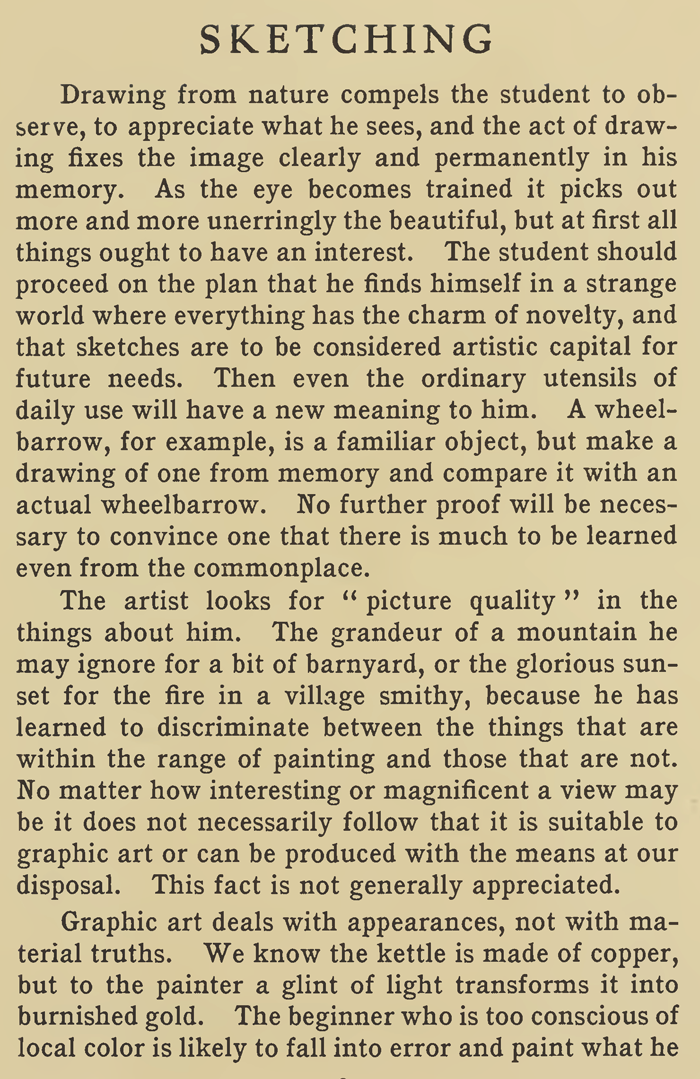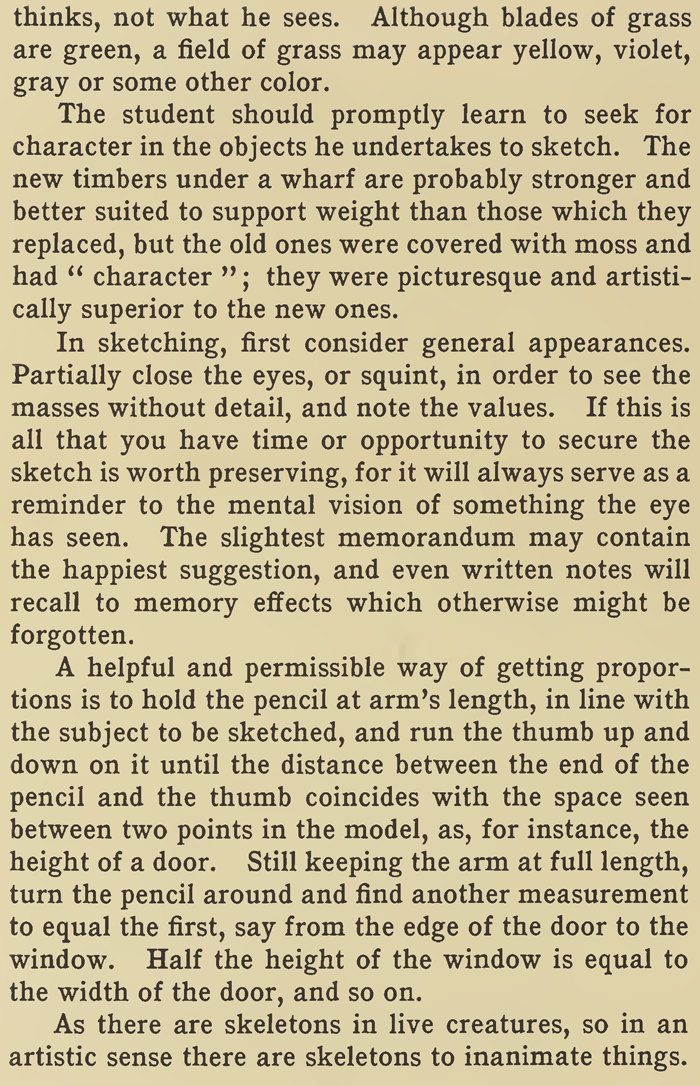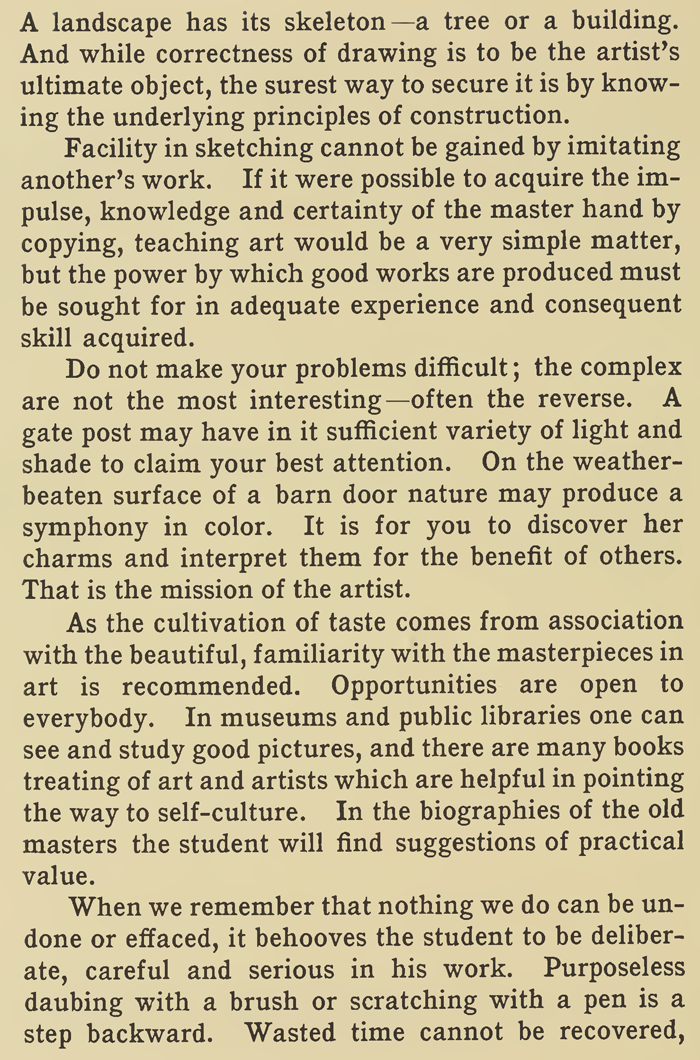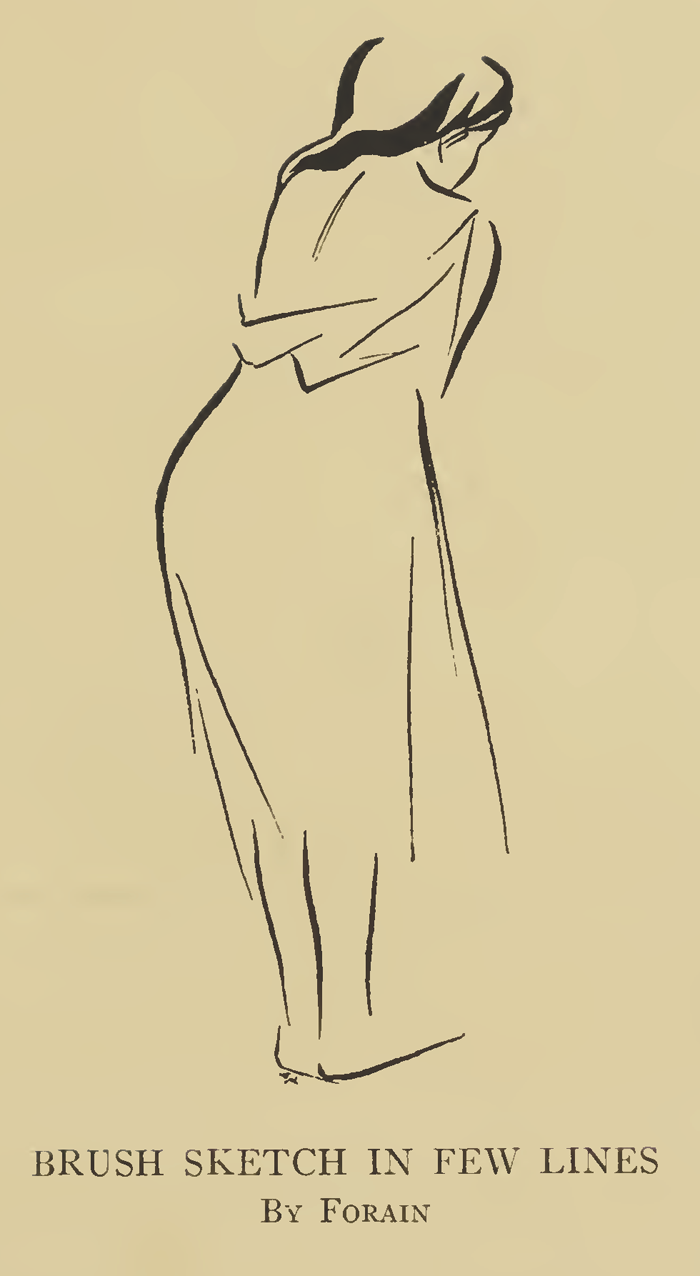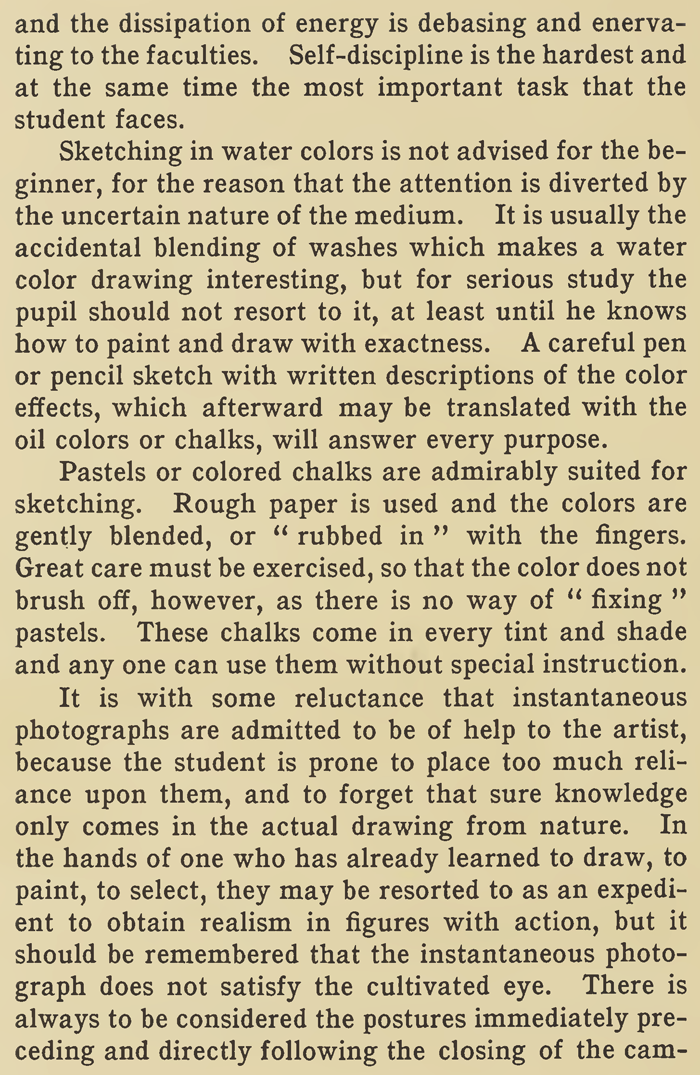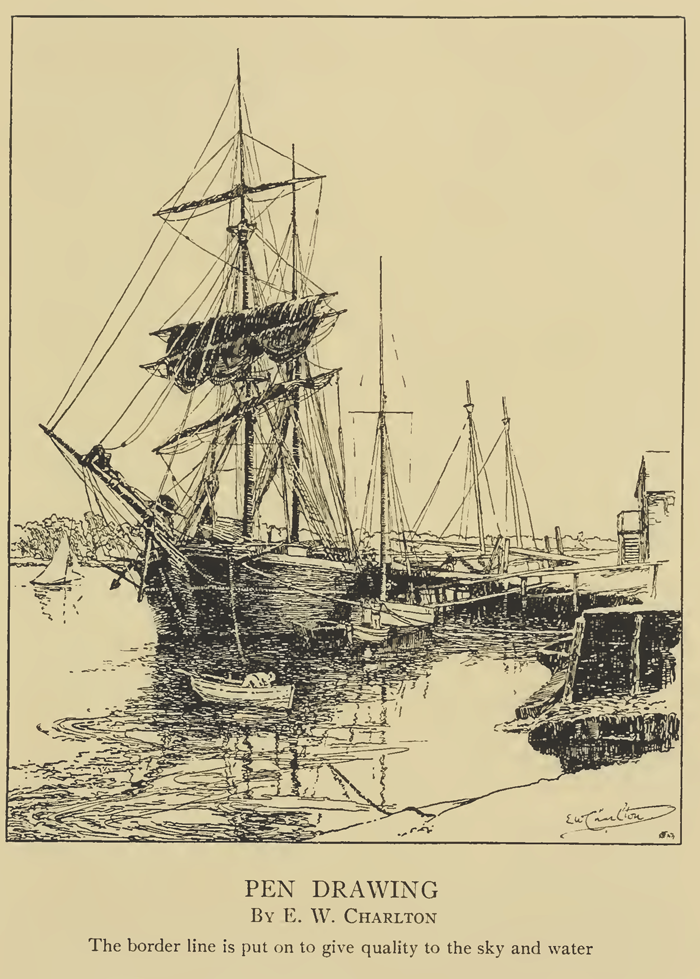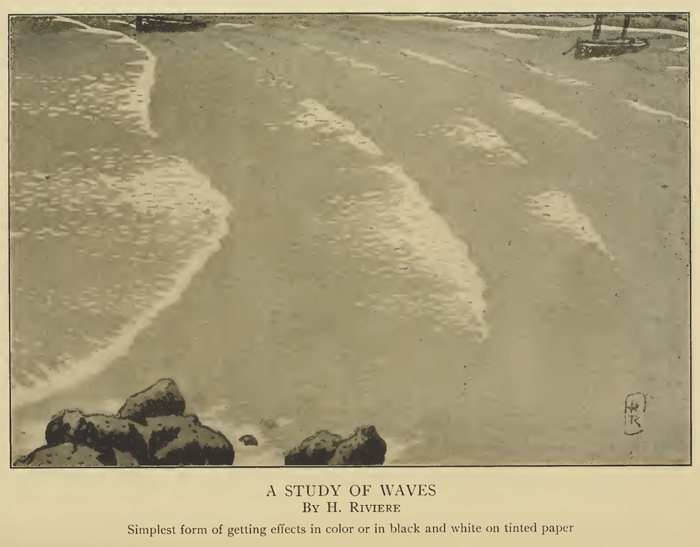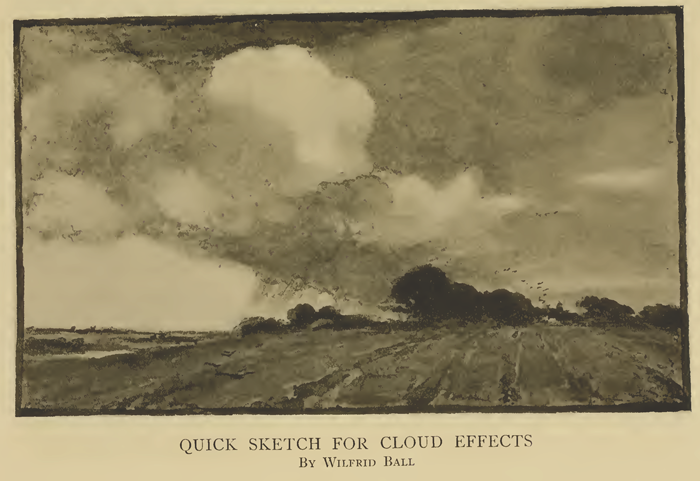Home > Directory of Drawing Lessons > Improving Your Drawings > Keeping a Sketchbook> Lines
Learning to Sketch : Beginners Sketching
|
|
Learning to Sketch : Beginners Sketching
DRAWING LESSONS IN EASY SKETCHINGDrawing from nature compels the student to observe, to appreciate what he sees, and the act of drawing fixes the image clearly and permanently in his memory. As the eye becomes trained it picks out more and more unerringly the beautiful, but at first all things ought to have an interest. The student should proceed on the plan that he finds himself in a strange world where everything has the charm of novelty, and that sketches are to be considered artistic capital for future needs. Then even the ordinary utensils of daily use will have a new meaning to him. A wheelbarrow, for example, is a familiar object, but make a drawing of one from memory and compare it with an actual wheelbarrow. No further proof will be necessary to convince one that there is much to be learned even from the commonplace. The artist looks for " picture quality " in the things about him. The grandeur of a mountain he may ignore for a bit of barnyard, or the glorious sunset for the fire in a village smithy, because he has learned to discriminate between the things that are within the range of painting and those that are not. No matter how interesting or magnificent a view may be it does not necessarily follow that it is suitable to graphic art or can be produced with the means at our disposal. This fact is not generally appreciated. Graphic art deals with appearances, not with material truths. We know the kettle is made of copper, but to the painter a glint of light transforms it into burnished gold. The beginner who is too conscious of local color is likely to fall into error and paint what he thinks, not what he sees. Although blades of grass are green, a field of grass may appear yellow, violet, gray or some other color. The student should promptly learn to seek for character in the objects he undertakes to sketch. The new timbers under a wharf are probably stronger and better suited to support weight than those which they replaced, but the old ones were covered with moss and had " character " ; they were picturesque and artistically superior to the new ones. In sketching, first consider general appearances. Partially close the eyes, or squint, in order to see the masses without detail, and note the values. If this is all that you have time or opportunity to secure the sketch is worth preserving, for it will always serve as a reminder to the mental vision of something the eye has seen. The slightest memorandum may contain the happiest suggestion, and even written notes will recall to memory effects which otherwise might be forgotten. A helpful and permissible way of getting proportions is to hold the pencil at arm's length, in line with the subject to be sketched, and run the thumb up and down on it until the distance between the end of the pencil and the thumb coincides with the space seen between two points in the model, as, for instance, the height of a door. Still keeping the arm at full length, turn the pencil around and find another measurement to equal the first, say from the edge of the door to the window. Half the height of the window is equal to the width of the door, and so on. As there are skeletons in live creatures, so in an artistic sense there are skeletons to inanimate things. A landscape has its skeleton —a tree or a building. And while correctness of drawing is to be the artist's ultimate object, the surest way to secure it is by knowing the underlying principles of construction. Facility in sketching cannot be gained by imitating another's work. If it were possible to acquire the impulse, knowledge and certainty of the master hand by copying, teaching art would be a very simple matter, but the power by which good works are produced must be sought for in adequate experience and consequent skill acquired. Do not make your problems difficult ; the complex are not the most interesting —often the reverse. A gate post may have in it sufficient variety of light and shade to claim your best attention. On the weather-beaten surface of a barn door nature may produce a symphony in color. It is for you to discover her charms and interpret them for the benefit of others. That is the mission of the artist. When we remember that nothing we do can be undone or effaced, it behooves the student to be deliberate, careful and serious in his work. Purposeless daubing with a brush or scratching with a pen is a step backward. Wasted time cannot be recovered, and the dissipation of energy is debasing and enervating to the faculties. Self-discipline is the hardest and at the same time the most important task that the student faces. Sketching in water colors is not advised for the beginner, for the reason that the attention is diverted by the uncertain nature of the medium. It is usually the accidental blending of washes which makes a water color drawing interesting, but for serious study the pupil should not resort to it, at least until he knows how to paint and draw with exactness. A careful pen or pencil sketch with written descriptions of the color effects, which afterward may be translated with the oil colors or chalks, will answer every purpose. Pastels or colored chalks are admirably suited for sketching. Rough paper is used and the colors are gently blended, or " rubbed in " with the fingers. Great care must be exercised, so that the color does not brush off, however, as there is no way of " fixing " pastels. These chalks come in every tint and shade and any one can use them without special instruction. It is with some reluctance that instantaneous photographs are admitted to be of help to the artist, because the student is prone to place too much reliance upon them, and to forget that sure knowledge only comes in the actual drawing from nature. In the hands of one who has already learned to draw, to paint, to select, they may be resorted to as an expedient to obtain realism in figures with action, but it should be remembered that the instantaneous photograph does not satisfy the cultivated eye. There is always to be considered the postures immediately preceding and directly following the closing of the camera shutter, which the artist in his picture combines or composes to give the impression of stability, and at the same time the sense of movement. The photograph of a man walking shows one foot suspended in the air ; of a horse running that he keeps one leg under him stiff and straight. But scientific facts when stated in art are to be modified to bring them into relationship with other things. There may be a temptation to copy a strikingly good photograph, and there are specious arguments to justify the practice—but although a quick lens and a quick plate are useful at times, their value to the artist is limited. In an instantaneous photograph the whirling wheels of an express locomotive look as they do in the picture taken while the engine is at rest, but a record of the billowy smoke pouring from the stack is worth getting ; the characteristics could not be obtained in any other way. A photograph, therefore, is to be taken for some specific purpose. The impression that artists pose models before commencing a picture and make servile copies of them is erroneous. The fact is, that the best drawings of figures in action are constructed without a model—from memory and afterward corrected from the model. Photographs may be utilized the same way. The pleasure derived from looking at a picture depends somewhat upon the spontaneity with which it is produced. The musician practises scales until his hands run over the keys without error. The music is before him ; he plays it readily at sight —spontaneously. So, through study, the pupil will be able to read nature at sight. By practise we also acquire the power of getting at the essence of a subject promptly, and the advantage of a reliable method is in knowing how we did a thing, and in being able to do it again. The freedom with which the masters in art resort to almost any medium in order to secure the record of an effect would seem extraordinary if the secret of excellence was not to be traced to higher qualifications than the dextrous management of materials. The lead pencil, chalks, charcoal, colors are all used.
|
Privacy Policy ...... Contact Us





